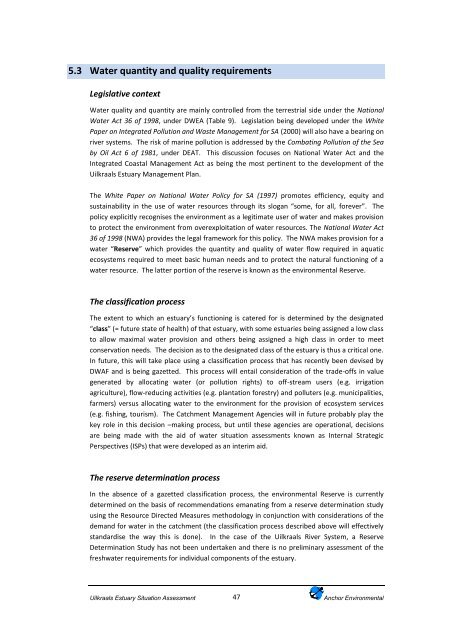Download PDF - Anchor Environmental
Download PDF - Anchor Environmental
Download PDF - Anchor Environmental
Create successful ePaper yourself
Turn your PDF publications into a flip-book with our unique Google optimized e-Paper software.
5.3 Water quantity and quality requirements<br />
Legislative context<br />
Water quality and quantity are mainly controlled from the terrestrial side under the National<br />
Water Act 36 of 1998, under DWEA (Table 9). Legislation being developed under the White<br />
Paper on Integrated Pollution and Waste Management for SA (2000) will also have a bearing on<br />
river systems. The risk of marine pollution is addressed by the Combating Pollution of the Sea<br />
by Oil Act 6 of 1981, under DEAT. This discussion focuses on National Water Act and the<br />
Integrated Coastal Management Act as being the most pertinent to the development of the<br />
Uilkraals Estuary Management Plan.<br />
The White Paper on National Water Policy for SA (1997) promotes efficiency, equity and<br />
sustainability in the use of water resources through its slogan “some, for all, forever”. The<br />
policy explicitly recognises the environment as a legitimate user of water and makes provision<br />
to protect the environment from overexploitation of water resources. The National Water Act<br />
36 of 1998 (NWA) provides the legal framework for this policy. The NWA makes provision for a<br />
water “Reserve” which provides the quantity and quality of water flow required in aquatic<br />
ecosystems required to meet basic human needs and to protect the natural functioning of a<br />
water resource. The latter portion of the reserve is known as the environmental Reserve.<br />
The classification process<br />
The extent to which an estuary’s functioning is catered for is determined by the designated<br />
“class” (= future state of health) of that estuary, with some estuaries being assigned a low class<br />
to allow maximal water provision and others being assigned a high class in order to meet<br />
conservation needs. The decision as to the designated class of the estuary is thus a critical one.<br />
In future, this will take place using a classification process that has recently been devised by<br />
DWAF and is being gazetted. This process will entail consideration of the trade-offs in value<br />
generated by allocating water (or pollution rights) to off-stream users (e.g. irrigation<br />
agriculture), flow-reducing activities (e.g. plantation forestry) and polluters (e.g. municipalities,<br />
farmers) versus allocating water to the environment for the provision of ecosystem services<br />
(e.g. fishing, tourism). The Catchment Management Agencies will in future probably play the<br />
key role in this decision –making process, but until these agencies are operational, decisions<br />
are being made with the aid of water situation assessments known as Internal Strategic<br />
Perspectives (ISPs) that were developed as an interim aid.<br />
The reserve determination process<br />
In the absence of a gazetted classification process, the environmental Reserve is currently<br />
determined on the basis of recommendations emanating from a reserve determination study<br />
using the Resource Directed Measures methodology in conjunction with considerations of the<br />
demand for water in the catchment (the classification process described above will effectively<br />
standardise the way this is done). In the case of the Uilkraals River System, a Reserve<br />
Determination Study has not been undertaken and there is no preliminary assessment of the<br />
freshwater requirements for individual components of the estuary.<br />
Uilkraals Estuary Situation Assessment<br />
47<br />
<strong>Anchor</strong> <strong>Environmental</strong>
















